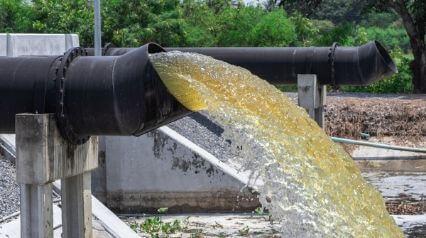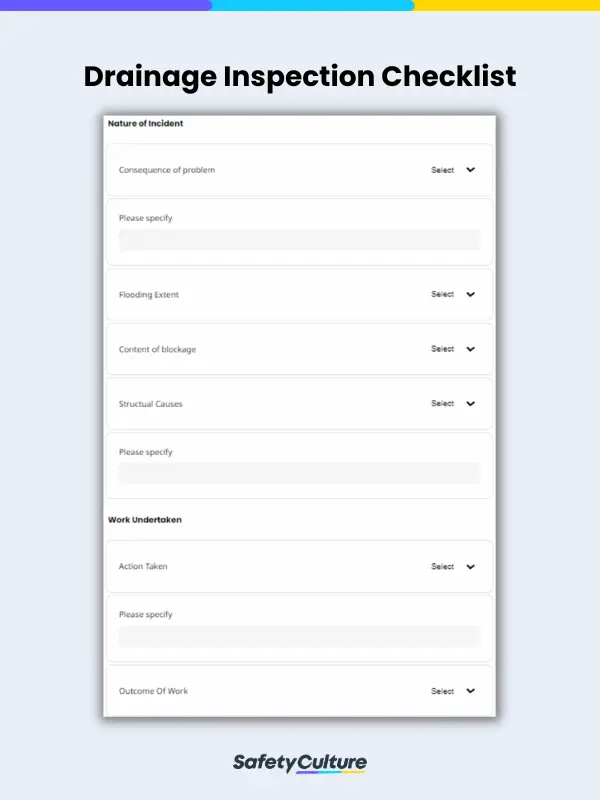What is a Drain Inspection?
A drain inspection is a systematic process of evaluating drainage systems to ensure
smooth wastewater transitions from pipeline to sewage systems. Performing a drain inspection aims to prevent drainage problems such as pipe cracks, corrosions, frost, and major clogs including tree roots, toilet paper buildup, and food waste.
Importance of Drain Inspection
Drain inspections are vital to help businesses prevent potential risks such as leaks, floods, and other public health and safety issues. Proper execution of drain inspections can:
- Detect early problems to eliminate expensive repairs;
- Prevent the hassle of slow water drainage and waste clogs;
- Mitigate the risk of damaged pipelines and drainages systems; and
- Increase and promote environmental safety.
What is a Drainage Inspection Checklist?
A drainage inspection checklist is a tool used by trained engineers, licensed plumbers, or drainage inspectors to ensure drainage systems are in good working condition. It is an accompanying tool with a drain camera system to easily record the location of defects and damages such as drain line clogs and pipeline leaks.
This article will briefly discuss (1) major causes of drainage blockages; (2) 12 effective tips to prevent drainage issues; (3) 4 ways to effectively report drainage inspections; and (4) free drainage inspection checklists you can customize and use.
Major Causes of Drainage Blockages
Maintaining your drainage systems can save your business from severe damage caused by sullage, unfiltered chemicals, drain line leaks, and odor-inducing problems. Below are the major causes of drainage blockage that you can attend to mitigate the risks:
Sanitary wastes
Sanitary waste such as hair strands, tissues, and feminine hygiene products are the most common causes of toilet drain blockage. Unable to control the disposal of sanitary waste can cause your business fines and penalty under the Environmental Protection Act 1990.
Industrial wastes
Industrial wastes are toxic materials produced by manufacturing industries. Flushing off unfiltered chemical wastes generated during the processing of products can cause drainage and sewage blockage that may lead to major environmental pollution.
Liquid wastes
Wastewater, sludges, oil, fats, or grease that are washed down the sink can cling to the pipes and eventually build up to where no liquid can pass through. Unmanaged liquid wastes can potentially harm human health due to disgusting odor.
Food wastes
Food wastes are a global problem and the most common rubbish present in hospitality industries. Throwing dishes directly to kitchen sinks without separating and filtering food wastes can cause blockage to pipelines that may lead to business operation downtimes and delays.
Plant matter
Root trees, shrubs, dirt, and leaves can cause issues with water drains depending on weather conditions. Root trees can grow inside water pipes which cause obstruction to water flow and pipeline damage. Furthermore, this may also lead to extensive and costly repairs.
12 Effective Tips to Prevent Drainage Blockage
Drainage system maintenance is necessary to prevent blocked or dammed channels from causing overbank flooding, unexpected erosion, and sedimentation. Poor drainage maintenance may result in a negative impact on your business which can cost you expensive repair on damages, environmental penalties, or worse property loss. You can avoid these hassles by performing regular drain surveys and implementing the following preventive tips to eliminate drain blockages:
- Do not flush napkins, toilet paper, or any non-biodegradable materials into your toilet drains.
- Install mesh screens over your drains to filter hair strands and other solid wastes.
- Install a water softener to prevent mineral buildup.
- Use a fat trap to dispose of waste oils and fats.
- Do not try to dispose of unused medicines through water drains, these can harm groundwater and be toxic to the environment.
- Do not treat your drains like a trash bin, dispose of your rubbish in designated areas.
- When washing mops and other cleaning tools, rinse the dirt and mud off before you scrub it on the sink.
- If a solid item accidentally falls off on your drain systems report it immediately.
- Cover your drain opening with grills to filter plant matter.
- If you are experiencing a slow water drain contact your facilities team to investigate as soon as possible.
- If there is a sudden formation of sheet ice, excavate out the ice formation to ensure water can flow away from the road area.
- Be aware of the property structure and perform regular drain maintenance.



